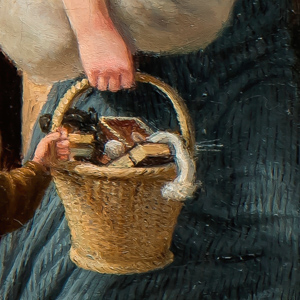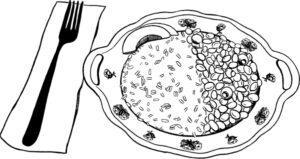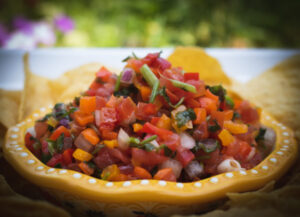The Timeless Tamale

Mrs. April Jaure
Every year, in my hometown — which boasts a large Mexican-American population — the grandmothers of the community prepare tamales for their families’ Christmas celebrations. The sale of tamales is also a favorite fundraiser of church and school groups. In many areas, women go door to door, selling homemade tamales by the basketful. They are delicious but a bit labor-intensive, and many younger people don’t know how to make them, or just don’t have the time, so when they’re available they get snatched up by the dozen.
This delightful, little dish holds a warm and colorful place in my winter memories and is common Christmas fare in many parts of the world — but not in all of them. Imagine my surprise when, as an adult, I was living and working in a small farming town in Wisconsin, and a young coworker said she knew how to make hot tamales and would be happy to bring some to the company party. I waited for the company event with happy anticipation. I truly hope my disappointment wasn’t visible when I realized what, in fact, my coworker (and many other Wisconsinites I have since learned) called a “hot tamale” is what other regions might call . . . a beef sandwich. Yes. She had prepared shredded beef in a crock-pot, to be eaten on a bun. It did taste good, but it definitely was not the tamale I was homesick for.
I don’t fancy myself a tamale purist, and I don’t typically quibble over names, but some culinary-nomenclature matters simply must not go unaddressed. Allow me, therefore, dear midwestern (and other uninitiated) readers, to introduce the veritable, venerable tamale. The recipe found below is not for hot beef sandwiches, nor is it for the popular oblong-shaped, cinnamon-flavored candy, which has somehow also picked up the moniker. It is for the quintessential, Central and South American food that contains seasoned meat (or other filling), surrounded by a corn dough, wrapped in a corn husk or banana leaf, and steamed.
The first tamales were made around 7000 B.C., even before the maize plant was completely domesticated (and predating the first ancient Egyptian sourdough bread by several thousand years). The various types of Aztec tamales were recorded in the Nahuatl language in the sixteenth-century work known as The Florentine Codex, written by Mexican scribes under the direction of Franciscan Spanish missionaries. There were many ways to make these ancient tamales. Some were made with pheasant or turkey, roasted pumpkin seeds, squash, beans, fish, or even edible flowers. Some tamales were savory and some sweet. As I grew up several hundred years after the arrival of Europeans, the recipe that I share below is not exactly how my ancient ancestors would have eaten them (it includes pork, for instance), but it is how I grew up eating them. Feel free to substitute shredded beef, chicken, or turkey instead, and if you really want to eat like the ancient Aztecs, experiment by filling tamales with any adventurous, new-world food you like.
Because tamales take some time to prepare, they are best when made in large quantities and eaten as part of a big, family celebration. It is said that food brings family together, so why not bring the family together for your next celebration, wrap up some tamales, and share laughter, company, and an ancient, delicious dish?
Below is the recipe that my husband and I favor. It makes about thirty tamales. Feliz Navidad!
— April
Tamales

Equipment:
Crock pot or dutch oven
StrainerBlender
Large pot with steamer basket
Ingredients:
Wrapping
1 pound bag of dried corn husks (found in the Mexican section of most grocery stores)
Chili puree
2 dried cascabel chilies
2 dried ancho chilies
2 dried pasilla chilies
1 small onion, chopped
3 cloves garlic
Salt, to taste
Filling
5 pound pork shoulder
2 bay leaves
2 teaspoon salt
2 garlic cloves
1/2 teaspoon ground cumin
Masa (the cornmeal dough)
3 cups masa harina (corn that has been soaked in lime water, then ground and dried)
2 1/2 cups lukewarm broth (from cooked pork)
1 1/2 teaspoon baking powder
1 teaspoon salt
1 cup lard (may substitute all or partial coconut oil)
Hojas (corn husks)
Put corn husks in water and let them soak for at least two hours. Put weight on husks to keep them submerged.
Chili puree
1. Remove seeds and stem from the dried chilies. You may wish to wear food preparation gloves for this step. Otherwise, just wash your hands well after working with the chilies.
2. Place chilies, onion, and garlic, in a saucepan, and add enough water to cover.
3. Bring to a boil, then simmer for 25 minutes. Remove from the heat and let cool.
4. Remove chilies, onions, and garlic from the pan and place in the blender. Add a cup of water to the blender (can be from the saucepan) and blend to make a paste. You may add more water if necessary.
5. Strain paste to remove large pieces, if needed.
6. Add salt to taste.
Filling
1. Trim excess fat off the pork shoulder and cut it into 2 to 4 large pieces. Put in a crockpot with the bay leaves, salt, cloves, and cumin. Add one cup of water, cover, and cook on high for five hours. You could also put the meat in a dutch oven, cover halfway with water, and simmer for two to three hours. The meat will be done when it can be shredded with a fork.
2. When done, remove pork and shred. Place in a bowl and set aside.
3. Strain the broth and set aside for the masa. Any meat pieces strained out can be added to the bowl with the rest of the shredded pork.
4. Mix one cup of the reserved chili puree into the meat. Add salt to taste, if needed.
Masa
1. In a large bowl, beat the lard with a tablespoon of the meat broth, until fluffy.
2. In a separate bowl stir masa harina, baking powder, and salt until combined.
3. Add the dry ingredients to the bowl of lard and mix, adding a small amount of the broth at a time as needed to form a spongy dough.
4. Add 3 tablespoons of the chili puree to the dough and knead in.
5. Once the masa is made, half a cup or more of the left-over broth can be added to the meat, just enough so the meat is moist.
Assemble the tamales
1. Remove the corn husks from the water and pat them dry with a clean dish towel.
2. Pick up a corn husk. Run your fingers across both sides of it. One side feels smoother than the other side. The masa will be spread on the smoother side.
3. With a butter knife or the back of a spoon, spread masa in a thin layer on the wider half of the corn husk. Some people like their masa in a very thin layer, some like it fairly thick. I like mine somewhere in between, about 1/8 to 1/4 inch thick, but you can adjust to your preference.
4. Place about two tablespoons of filling in the center of the masa.
5. Fold the sides of the corn husk toward the center over the filling, then fold up the bottom half (the half without masa) of the husk. When the cooked tamales are unwrapped, the meat should be surrounded by masa.
6. Some corn husks are wide, and some thin. This is okay. Whatever the size of the corn husk, spread on some masa, fill with meat, and wrap it up. Some tamales may be skinny and some fat, but in a family with elderly, middle-aged and young adults, children, and toddlers, variable sizes are perfectly acceptable, and even preferred.
Steam the tamales
1. Put some water in a pot with a steamer basket. In the center of the basket, place a small glass bowl upside down.
2. One at a time, take the assembled tamales and arrange them around the bowl teepee style, with the open end of the tamales up. The bowl helps the tamales stand upright. Add the remaining tamales around the first. Depending on how many tamales you make and the size of your pot, they may need to be steamed in batches. Pack them in so the tamales can be upright, but be aware that if they are packed too tightly they will take longer to steam. If there is room, you can even add another layer of tamales on top of the first layer.
3. Once the tamales are arranged in the pot and ready to steam, cover them with several more corn husks. Put on a tight-fitting lid, bring the water to a boil, then turn down to a simmer and steam for about an hour. The tamales are ready when the masa separates easily from the husk.
Notes:
Although making tamales requires many steps, it can be broken up over several days if needed. The meat can be cooked ahead of time and the broth reserved. The chili paste can be made ahead of time as well. I recommend making the masa fresh, when you are ready to assemble the tamales. Assembling the tamales is the most labor-intensive part, so if everything is prepared ahead of time, once the family is together, everyone can help assemble them. Steam them for an hour, in batches if needed, and enjoy fresh tamales. If needed, tamales can be made ahead of time and refrigerated, or even frozen for up to six months.
The chilies listed above are the types I use for my family. My children do not like food that is too spicy, so these low- to medium-heat chilies provide a nice flavor with not too much heat. Some people use different types of chilies, however, and if you want to amp up the heat you can use hotter chilies. Adding more or less chili puree to the masa will also affect the spiciness of the tamales.
There are many right ways to prepare tamales (except perhaps by putting them in a bun). You can experiment with the types of chilies you use, what meat or vegetable is used for the filling, how thick you spread the masa, and whether or not you add chili puree to the masa and how much. Some regions wrap the tamales in banana leaves instead of corn husks. If taken one step at a time, it needn’t be intimidating.
Remember to remove the corn husk before eating!



















